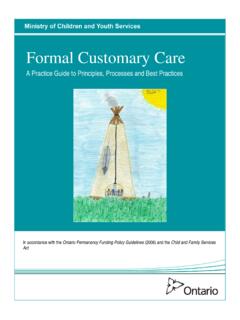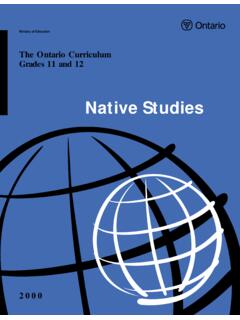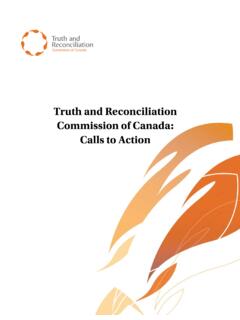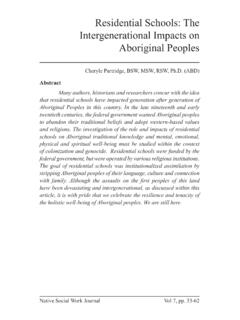Transcription of Trauma Informed Practice: Working with Indigenous Individuals
1 Trauma Informed Practice: Working with Indigenous IndividualsMoving from what s wrong with you to what has happened to you Lisa George MEd, CCC Sarah Newton, RN(EC)Dominique-Michelle Legacy OT Reg(Ont) Seeds to Walk Away With Connecting Past & Present Understanding Trauma and its Impacts Understanding Principles of Trauma Informed Care Putting it into Practice: the challenges and rewards500 Years in 2 Minutes(WabKinew)Why is the Past Important? In order to best support the Indigenous person in front of you, it is important to know the journey they have been through. Please recognize that Colonialism isdefined as control by one power over a dependent area or people .
2 It occurs when one nation subjugates another, conquering its population and exploiting it, often while forcing its own language and cultural values upon its people . Racism and colonization are intertwined and together deeply impact the health of Indigenous peoples of Canada. Systemic Trauma and racism underlines every aspect of an Indigenous person s life and if we want to see different outcomes, we have to be willing to try to do our work differently. Creating Understanding and RespectUntil recently, most Canadians did not learn history from the point of view of Indigenous people .
3 Forced relocation from traditional territories to make way for settlers (the start of the Reserve system) Indian Act Residential schools Placement of thousands of Indigenous children in non- Indigenous families for adoption (called the Sixties Scoop) Indian Hospitals segregated health care servicesA Brief History 1800-1900 s the policy of the federal government of Canada was to clear the land of the Aboriginals and open the west to Euro-Canadian agricultural settlements Indian Act (1876) provides legal framework to control Indigenous life and culture still exists to this day Department of Indian Affairs (1880)
4 Manages Indigenous people under the Indian Act Now called the Department of Indigenous and Northern Schools Operated 1892 -1969 through arrangements between the federal government and the Roman Catholic, Methodist, Anglican, United and Presbyterian churches Government of Canada officially ended involvement in 1969 but schools continued to operate until the 1970 s-1980 s with the final one closing in 1996 Intent was to separate the children from their families and culture to re-socialize them to accept and practice what was believed to be a superior European culture and value system Our Health Counts -London 41% have had CAS involved when they were children; 50% have had CAS involved in the care of their children.
5 60% found the impact to be negative 55% were unemployed compared to 7% 90% fell below the Before Tax Low-Income Cut Off 62% have experienced racism 1 in 4 have been treated unfairly by health professionals due to being Indigenous 20% were precariously housed or homeless 1 in 4 have had a close friend of family member go missing 1 in 3 have had a close friend of family member die as a result of domestic violence caused by another person 70% have at least one family member attend residential school 80% experienced at least one type of household violence as an adultThe Legacy For Indigenous people , the legacy of Canadian history includes persistent inequities in determinants of health, health status, and health outcomes aboriginal Peoples continue to experience conditions of persistent disadvantage, including a greater likelihoodofsuffering violent crimes and physical, emotional or sexual abuse.
6 May also include mistrust of non- Indigenous institutions ( , governments and public services) Many Indigenous people prefer not to access mainstream health care services Not Culturally safe ( , stereotyping/racism) Not aligned with cultural values/practices (Western approach to health care can feel alienating)Historical Trauma Complex in its causes, evolution & outcomes Collective Experience; shared by members of an identifiable group who have experienced it over generations Cumulative in impacts over time Intergenerational in its impacts Health & Social Service Workers need to recognize the connections between historical Trauma and contemporary traumaWhat is Trauma ?
7 DSM VExposure to actual or threatened death, serious injury, or sexual violence in one (or more) of the following ways: -directly experiencing the traumatic event(s); -witnessing, in person, the traumatic event(s) -as it occurred to others; -learning that the traumatic event(s) occurred to a close family member or close friend (in case of actual or threatened death of a family member or friend, the event(s) must have been violent or accidental); -or experiencing repeated or extreme exposure to aversive details of thetraumatic event(s) (p. 271)Internal Music: Monitor Your Response After all, when a stone is dropped into a pond, the water continues quivering even after the stone has sunk to the bottom (Arthur Golden, Memoirs of a Geisha)ACE s StudyAdverse Childhood ExperiencesAbuse Emotional Physical SexualNeglect Emotional PhysicalHousehold Dysfunction Mother treated violently Household Substance Abuse Household Mental Illness Parental separation or divorce Incarcerated household memberFindings.
8 67% of participants experienced at least 1 ACE Over 25% reported 2 or more Over 12 % reported 4 or more Machtinger, , et al (2015)ACE Score & Health Risk Alcoholism and alcohol abuse Chronic Heart Disease (eg. Ischemic Heart Disease) Chronic Lung disease (eg. COPD) Depression, Anxiety, Suicide Attempts Decline in health related quality of life Diabetes Early initiation of sexual activity, increased risk for STIs, unplanned pregnancies Liver Disease Risk for Intimate Partner Violence Smoking (and early initiation of) Substance use and misuseAs The ACE Score increases the risk of these health problems increases in a strong dose-response relationshipMachtinger, , et al (2015)
9 Other important ACE Study Findings Women experienced more adverse events in childhood than men Higher incidence of adverse events for those living in poverty The effects of childhood adversity can be magnified through generations Machtinger, , et al (2015)The Impact of Trauma Over The LifespanWindow of ToleranceGrounding activityWhy is this Important? Understanding Trauma and its impacts is critical to the provision of Trauma Informed care Past history of Trauma has a significant impact on current health status and function Past history of Trauma can impact the way Individuals access health and social servicesWhat is Trauma Informed Care (TIC)?
10 SAMHSA s Trauma Informed Approach (Lang et al., 2015)Story of JaneRe-Traumatization Touch, smell, noises Power dynamics of a relationship Gender of provider Loss of and lack of privacy Look of the environment Specific wording or wordsPutting into practice Culturally safe and welcoming waiting area, front desk and meeting room Ex. Indigenous art, medicines available, resources available for Indigenous clients . Have food and beverages available for clients. If client seems anxious, provide an alternate location where you can establish safety. Offer smudging or grounding techniques.








